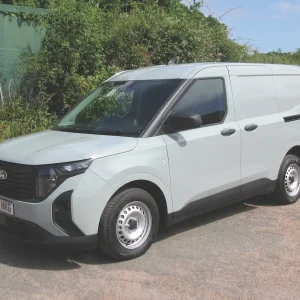Mounted underneath the vehicle, they can be fully recharged in around eight hours from a three-phase supply. Regenerative braking helps to keep them topped up.
Top speed is an electronically-limited 45mph. The power output is 30kW continuous (60kW peak) for the 3.5-tonners and 40kW continuous (80kW peak) for the 5.2 tonners and you should be able to pull away fully-laden on a 16 per cent gradient.
While the absence of a diesel engine, a conventional gearbox and a diesel tank brings the unladen weight down, adding an electric motor plus batteries puts it back on again. The net result is a payload loss of around 250kg to 300kg if two batteries are installed.
They’ll give the 3,300mm-wheelbase 35S 3.5 tonne van a 55-mile range and a 1,000kg payload capability. Go for three batteries and you’ll bump up your range to 75 miles, but reduce your payload potential to 800kg.

On the Road
We braved the congested streets of London in a 35S van with a 500kg test load on board. Settle down behind the wheel and you’ll see that the cab is virtually the same as that of the standard Daily aside from a lever instead of a conventional gearstick and a display giving you the battery’s level of charge
Use the lever to put the vehicle into ‘D’ for Drive — you tap it to the left — press the accelerator pedal having released the brakes and you’re off. There are no gears to change and because an electric motor yields its maximum torque instantly — 230Nm in this case — you can pull away rapidly from rest.
With all that performance on tap we were more than capable of keeping up with the traffic and taking advantage of any suitable gaps that presented themselves.
We did so almost silently. The only sources of noise were the tyres and the electric motor, which emitted a muted hum.
The lack of racket is good news if you’re making early morning or late night deliveries, but also means that you need to be particularly careful when pedestrians or cyclists are about. They may not hear you coming.
At low speeds the zero-tailpipe-emission Daily was surprisingly biddable. It showed no inclination to go hurtling forwards or backwards when we parked it just so long as we were gentle with the loud (surely silent? – ed) pedal.
Most of our running around town was in the congestion charge zone; a zone that an electric Daily can enter free-of-charge. Nor does it attract road tax, maintenance costs are minimal and the electricity it uses will typically set you back no more than 5.5p a mile says Iveco.
Sounds good so far, but here comes the bad news. Prices for the 35S start at a wallet-numbing £63,000 including the batteries, falling to a less-painful, but still eye-watering, £40,000 if you elect to lease them separately.
There’s no denying that the EcoDaily Electric is a viable urban load-shifter. If you’re delivering parcels and packages around the City of London, for example, and spend most of your time inching along in heavy traffic, then it’s ideal. Under those conditions it’s unlikely that you’ll need to use its entire range during the course of a working day. But although it’s cheap to run, it’s not cheap to acquire. At some point the batteries will need replacing — that’s going to be expensive — and there’s a question mark over the vehicle’s likely second-hand value.
While there are no nasty tailpipe emissions, never forget that the power the batteries use has to come from somewhere; and in the UK much of it is likely to come from a power station that burns fossil fuel; around 80 per cent of them do.

Verdict
For the moment then the electric Daily is likely to be a low-volume seller. Sales could rise longer-term as battery costs come down and as battery-driven vans become more widely accepted; but diesel will still dominate the market.






